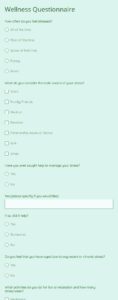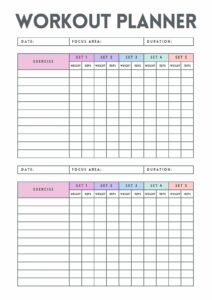Embarking on a physical therapy journey is a commendable step towards recovery and improved well-being. Whether you’re mending from an injury, managing a chronic condition, or enhancing your physical capabilities, consistency and proper execution of your prescribed exercises are absolutely crucial. It’s not always easy to remember every rep, set, and specific instruction, especially when you have a variety of movements to perform daily.
This is where having a reliable method to track your progress becomes incredibly valuable. Keeping a diligent record of your workouts allows you to monitor your journey, observe improvements, and stay motivated on those days when recovery feels like a slow climb. A structured approach can make all the difference in ensuring you get the most out of every session and communicate effectively with your therapist about your progress and challenges.
The Power of Tracking Your PT Progress
Imagine being able to look back over weeks and months of hard work and clearly see how far you’ve come. That’s the primary power of an exercise log. It transforms abstract effort into tangible data, showing you improvements in strength, flexibility, endurance, or reduced pain levels. This objective feedback can be a massive source of motivation, especially when you might feel discouraged by slow progress. Seeing those numbers shift, even slightly, can reinforce your commitment.
Beyond personal motivation, a detailed log serves as an invaluable communication tool between you and your physical therapist. Instead of relying on fuzzy recollections, you can provide precise information about how many sets and reps you completed, the resistance you used, and, most importantly, how your body responded. Did a particular exercise cause more pain than usual? Did you manage more repetitions this week without discomfort? This data helps your therapist make informed decisions about adjusting your program, ensuring you’re always progressing safely and effectively.
Furthermore, maintaining a log fosters a sense of accountability and self-discipline. It encourages you to stick to your routine, even on busy days, because you know you’ll be recording your efforts. This consistent engagement with your recovery plan can lead to better long-term outcomes, making the healing process more efficient and sustainable. It’s about taking an active role in your own health.
What to Include in Your Log
To make your tracking truly effective, your log should capture specific, relevant information. While you can customize it to your needs, some core elements are essential for any physical therapy exercise log template. Think of it as a blueprint for success, guiding you to record the most important details every time you exercise.
- Date: Always start with the date to track progress over time.
- Exercise Name: Clearly list each specific exercise prescribed by your therapist.
- Sets/Reps/Duration: Record how many sets and repetitions you completed, or the duration if it’s a timed exercise (e.g., holding a stretch for 30 seconds).
- Resistance/Weight: Note any weights, resistance band levels, or settings on machines you used.
- Pain Level: This is crucial. Use a simple scale (e.g., 0-10, where 0 is no pain and 10 is the worst imaginable pain) to indicate discomfort before, during, and after each exercise.
- Notes/Observations: This section is your personal space to record anything else relevant. Did you feel a stretch in a new area? Was it easier or harder than last time? Did you notice any clicking or popping? These subjective observations are just as important as the objective numbers.
Consistently filling out these sections will create a comprehensive history of your rehabilitation journey. It allows you and your therapist to spot patterns, identify triggers for pain, and celebrate milestones, no matter how small they may seem at the time.
Creating Your Ideal Physical Therapy Exercise Log Template
When it comes to organizing your exercise data, you have several options, from a simple spiral notebook to dedicated apps or printable sheets. The key is to choose a format that you find easy to use and will stick with consistently. A pre-designed physical therapy exercise log template can save you time and ensure you don’t miss any critical information, offering a structured layout that prompts you for all the necessary details.
Whether you prefer a digital spreadsheet, a printable PDF, or even sketching your own grid in a journal, the most effective log is one that you enjoy using. Some people love the tactile experience of writing things down, while others prefer the convenience of typing notes on their phone. There’s no single right way, so explore what resonates with you and makes the logging process feel less like a chore and more like an integral part of your self-care routine.
A good template simplifies the recording process. It provides clear headings for each piece of information, making it quick and intuitive to fill out after each session. This structure helps you maintain consistency, preventing you from skipping important details or finding the logging process too cumbersome. Think about how you can streamline it to fit into your daily life without adding unnecessary stress.
To truly make your log work for you, here are a few tips to keep in mind:
- Choose a format that works for you: Digital, printable, or a physical notebook.
- Keep it accessible: Have your log ready to go immediately after your exercises.
- Be honest with your entries: Record pain levels and difficulties accurately, even if they’re not what you hoped for. This data is for your benefit.
- Review it regularly: Take a moment each week to look back at your progress or challenges.
- Don’t be afraid to adjust it: If a section isn’t working or you need to add something new, feel free to customize your template.
By diligently tracking your physical therapy exercises, you’re not just creating a record; you’re actively engaging with your healing process and empowering yourself with knowledge. This consistent effort will not only lead to better communication with your therapist but also provide you with a clear roadmap of your accomplishments and areas for continued focus. Embrace this tool as a vital part of your journey back to strength and mobility, celebrating every step forward along the way.

